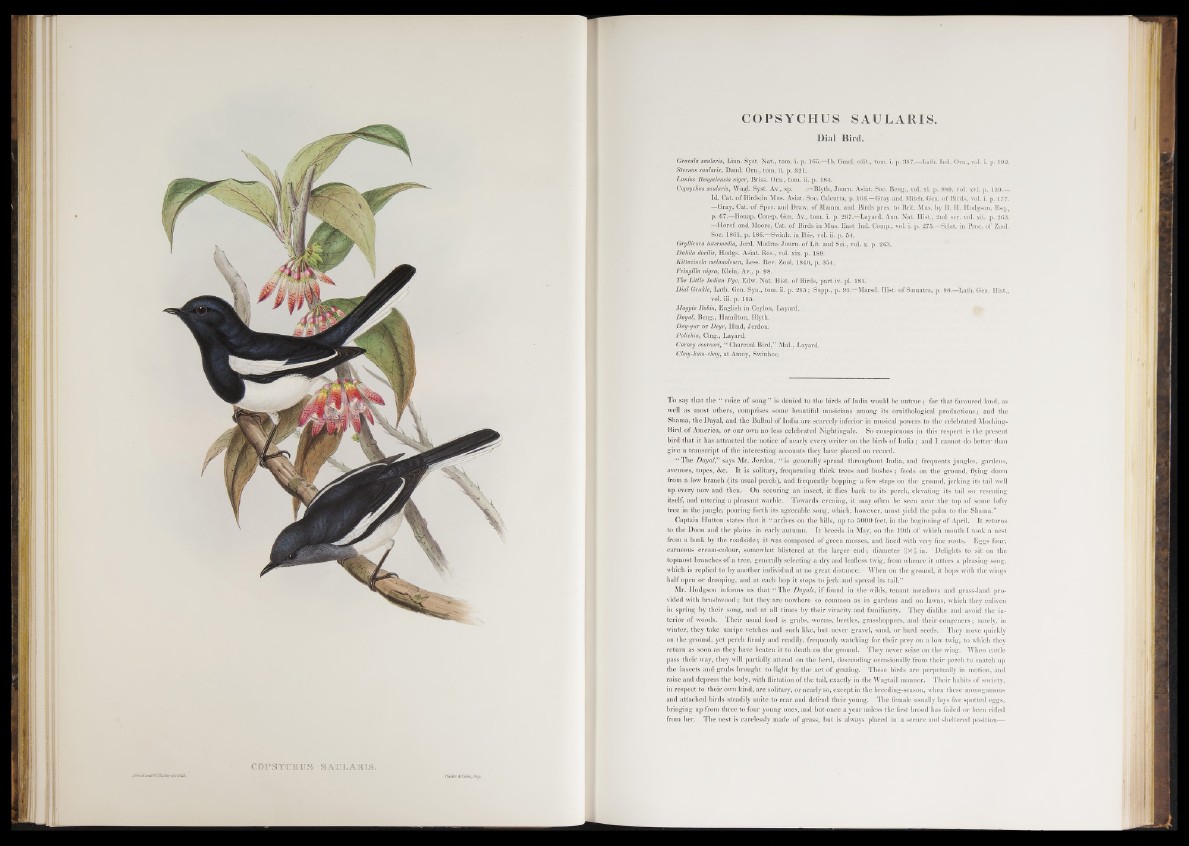
COPSYCHTJS SATJLAHIS.
Maiid-HCJiichUr.iuitllti}:
COPSYCHUS SAULARIS.
Dial Bird.
Gracula saularis, Linn. Syst. Nat., tom. i. p. 1 6 5—lb. Gmel. edit., tom. i. p. 397 Lath. Ind. Orn., vol. i. p. 192.
Stemus saularis, Daud. Om., tom. ii. p. 321.
Lanius Bengalensis niger, Briss. Orn., tom. ii. p. 184.
Copsyckus saularis, Wagl. Syst. Av., sp. .•—Blyth, Journ. Asiat. Soc. Beng., vol. xi. p. 889, vol. xvi. p. 139__
£r-: Id. Cat. of Birdsfin Mas. Asiat. Soc. Calcutta, p. 166.—Gray and Mitch. Gen. of Birds, vol. i. p. 177.
—Gray, Cat. o f Spec, and Draw, of Mamm. and Birds pres, to Brit. Mus. by B. II. Hodgson, Esq.,
p. 67-.-—Bonap. Consp. Gen. Av., tom. i. p. 267.—Layard, Ann. Nat. Hist., 2nd ser. vol. xii. p. 263.
—Horsf. and Moore, Cat. of Birds in Mus. East Ind. Comp., vol. i. p. 275.—Sclat. in Proc. of Zool.
Soc. 1861, p. 186.—Swinh. in Ibis, vol. ii. p. 54.
Gryllivora intermedia, Jerd. Madras Journ. o f Lit. and Sci., vol. x. p. 263.
Dahila docilis, Hodgs. Asiat. Res., vol. xix. p. 189.
Kittacincla meldnoleuca, Less. Rev. Zool. 1840, p. 354.
Fringilla nigra, Klein, Av., p. 98.
The Little Indian Pye, Edw. Nat. Hist, o f Birds, part iv. pi. 181;
Dial Grakle, Lath. Gen. Syn., tom. ii. p. 265; Supp., p. 91.—Marsd. Hist, o f Sumatra, p. 98.—Lath. Gen. Hist.,
vol. iii. p. 165.
Magpie Robin, English in Ceylon, Layard.
Dayal, Beng., Hamilton, Blyth.
Day-yur or Deyr, Hind, Jerdon.
Polichia, Cing., Layard.
Caravy cooroon, “ Charcoal Bird,” Mai., Layard.
Chuy-kam-chay, at Amoy, Swinhoe.
To say that the “ voice of song” is denied to the birds of India would be untrue; for that favoured land, as
well as most others, comprises some beautiful musicians among its ornithological productions; and the
Shama, the Dayal, and the Bulbul o f India are scarcely inferior in musical powers to the celebrated Mocking-
Bird of America, or our own no less celebrated Nightingale. So conspicuous in this respect is the present
bird that it has attracted the notice of nearly every writer on the birds of In d ia; and I cannot do better than
give a transcript of the interesting accounts they have placed on record.
“ The Dayal," says Mr. Jerdon, “ is generally spread throughout India, and frequents jungles, gardens,
avenues, topes, &c. It is solitary, frequenting thick trees and bushes; feeds on the ground, flying down
from a low branch (its usual perch), and frequently hopping a few steps on the ground, jerking its tail well
up every now and then. On securing an insect, it flies back to its perch, elevating its tail on reseating
itself, and uttering a pleasant warble. Towards evening, it may often be seen near the top of some lofty
tree in the jungle, pouring forth its agreeable song, which, however, must yield the palm to the Shama.”
Captain Hutton states that it “ arrives on the hills, up to 5000 feet, in the beginning of April. It returns
to the Doon and the plains in early autumn. It breeds in May, on the 19th of which month I took a nest
from a bank by the roadside; it was composed of green mosses, and lined with very fine roots. Eggs four,
carneous cream-colour, somewhat blistered a t the larger end ; diameter SSXrain. Delights to sit on the
topmost branches of a tree, generally selecting a dry and leafless twig, from whence it utters a pleasing song,
which is replied to by another individual at no great distance. When on the ground, it hops with the wings
half open or drooping, and at each hop it stops to jerk and spread its tail.”
Mr. Hodgson informs us that “ The Dayals, if found in the wilds, tenant meadows and grass-land provided
with brushwood; but they are nowhere so common as in gardens and on lawns, which they enliven
in spring by their song, and at all times by their vivacity and familiarity. They dislike and avoid the interior
of woods. Their usual food is grubs, worms, beetles, grasshoppers, and their congeners; rarely, in
winter, they take unripe vetches and such like, but never gravel, sand, or hard seeds. They move quickly
on the ground, yet perch firmly and readily, frequently watching for their prey on a low twig, to which they
return as soon as they have beaten it to death on the ground. They never seize on the wing. When cattle
pass their way, they will partially attend on the herd, descending occasionally from their perch to snatch up
the insects and grubs brought to light by the act of grazing. These birds are perpetually in motion, and
raise aud depress the body, with flirtation of the tail, exactly in the Wagtail manner. Their habits of society,
in respect to their own kind, are solitary, or nearly so, except in the breeding-season, when these monogamous
and attached birds steadily unite to rear and defend their young. The female usually lays five spotted eggs,
bringing up from three to four young ones, and but once a year unless the first brood has failed or been rifled
from her. The nest is carelessly made o f grass, but is always placed in a secure and sheltered position—